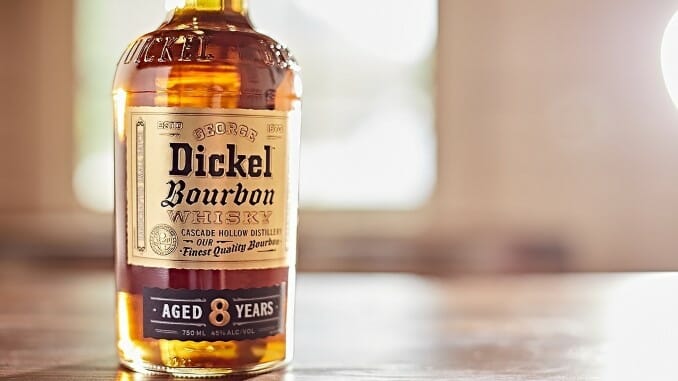George Dickel Bourbon Whisky (8 Year Old)
Photos via George Dickel, Diageo
When it comes to George Dickel, labels just have a tendency to get confusing pretty quickly. This isn’t Jim Beam, where you can just slap the term “straight bourbon” on the majority of the product lineup and be done with it. The Diageo-owned Dickel instead maintains its own little idiosyncrasies, at least partially stemming from its proud title of Tennessee Whiskey, rather than “Kentucky bourbon producer.”
Case in point: Most Dickel flagship products could legally qualify as bourbon—they’re made from primarily corn mash bills and aged in newly charred oak—but Dickel, like Jack Daniels, chooses to be known as Tennessee Whiskey instead in recognition of their use of traditional charcoal filtration techniques. However, they spell the word whiskey as “whisky,” in the Scottish style—just another of those little idiosyncrasies. They also maintain not one but two flagships at almost the exact same price point: Dickel No. 8 at around $22, and Dickel No. 12 around $24. Those numbers are not age statements, as the casual observer might assume, but are instead implied to be recipe numbers, although the rest of the specs are probably as you would imagine them. No. 12 is a bit stronger than No. 8 (45% vs. 40% ABV), and is implied to be a bit older, although both are non-age-stated. There’s a fair amount of grey area.
Making things that much more confusing, though, is the newly released George Dickel Bourbon. It’s the first time that Dickel has ever released a product actually using the term “bourbon,” and this time around the large “8” emblazoned on the front is a literal age statement rather than a recipe number. Visually, it’s hard not to note the similarities to George Dickel No. 8, which seems to imply that George Dickel Bourbon will cause its fair share of liquor store confusion. The intent here, however, seems to be shooting for the bourbon mid-shelf, with a $33 MSRP that puts it in territory shared by brands such as Knob Creek, Four Roses Small Batch, and Elijah Craig Small Batch.
As for why this new product would be labeled as “bourbon” when none of the others are, the company says it’s a matter of taste. Cascade Hollow Distilling Co. (where Dickel is made) General Manager and Distiller Nicole Austin has in recent years become a superstar in the whiskey field for her blending and barrel-picking abilities, so this product launch represents another opportunity for the distillery to lean on her respected reputation, which has become increasingly central to Dickel’s marketing. Austin says that these particular barrels “leaned into more traditional bourbon notes and did not express the Tennessee Whiskey tasting characteristics found in the rest of the George Dickel offerings,” so there’s your rationale. It does make one wonder what the specific differences are that Austin sees between “traditional bourbon notes” and “Tennessee whiskey characteristics.”
Still, it results in increasing compartmentalization of the George Dickel lineup, sticking a new mid-tier product in among already established brands. With the addition of George Dickel Bourbon, you now have Dickel No. 8 and No. 12 in the $20 range, George Dickel Bourbon in the $30 range, and both the well-loved George Dickel Bottled in Bond (not labeled as bourbon) and George Dickel Barrel Select in the $40 range. One has to wonder if there was a big enough unexploited niche between these brands for a new George Dickel Bourbon to really stand out and find a fandom of its own. At a certain point, we must be splitting hairs, although it’s only fair to note that the overall value of pretty much everything in the lineup is on the high side, as Dickel is known for. Whiskey sourced from Dickel, on the other hand, can rarely match that value, although it ironically seems to create more hype.
-

-

-

-

-

-

-

-

-

-

-

-

-

-

-

-

-

-

-

-

-

-

-

-

-

-

-

-

-

-

-

-

-

-

-

-

-

-

-

-








































